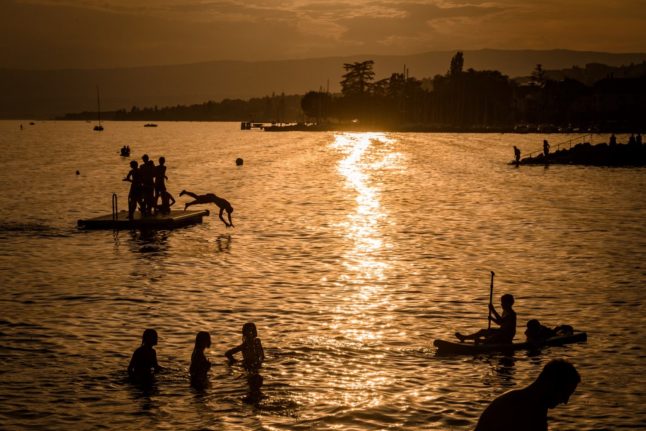With 36.9C recorded in Beznau, in the canton of Aargau on Sunday, Switzerland equalled the high temperature record held by Basel since 1947.
Other Swiss towns experienced sweltering temperatures as well: In Neuchâtel the mercury rose to 36.5C, in Sion it hit 36.4C and in Lausanne it was 32.6C, according to MeteoNews.
Temperatures were decidedly more pleasant at high altitudes in the mountains: the temperature of 16.9C was recorded at 2,900 metres in the shade on the Diablerets glacier.
Whilst lower down at the Moléson in Fribourg, which stands at 2,000 metres, a more seasonal 24 degrees was recorded.
Like its neighbours, “Switzerland is not immune to brief and extreme phenomena”, climatologist Martin Beniston, honorary professor at the University of Geneva, said in an interview with Tribune de Genève.
And if high temperatures continue — as they are forecast for next days — “the very dry ground will reinforce the warming, it is a vicious circle”, said Vincent Devantay, meteorologist from MeteoNews.
This means higher risk of fires, especially in the forest. “They have really dried up compared to last year. The lack of rain is becoming extremely worrying”, he pointed out.
Thunderstorms are predicted in parts of Switzerland towards the end of the week but they will not necessarily prevent the drought, Beniston said.
What the soil needs are “gentle showers, repeated, for two to three weeks”, rather than occasional heavy thunderstorms that don’t provide enough moisture for the earth’s deeper layers.
Continued rains are not expected in the immediate future and forecasts for the summer months predict more intense heatwaves.
READ MORE: How this week’s heatwave will hit Switzerland and how to stay cool
What are the consequences of the heatwave and no rain?
As The Local already reported, Swiss glaciers are now melting faster than usual, partly due to the early heat wave in May.
READ MORE: Why Switzerland’s glaciers are melting faster than usual this summer
But there is more.
Hydrologist Massimiliano Zappa, also warns that current very high temperatures and no rain could speed up the drought across Switzerland, especially as Swiss rivers and streams “have a lower flow than the average of previous years”.
Water rationing could become inevitable, he said.
“In Spain and southern Italy, for example, people know how to get by with little water, because they have been educated to meet their daily needs with less. But this is not part of Swiss mentality”, Zappa said.
The heat wave could also impact railway installations as well as electronic devices, according to Le Temps newspaper.
“Overheated smartphones, expanding rails, and computer fans running at full speed: high temperatures put a strain on infrastructure and our everyday objects, while requiring more energy”, Le Temps said.




 Please whitelist us to continue reading.
Please whitelist us to continue reading.
Member comments